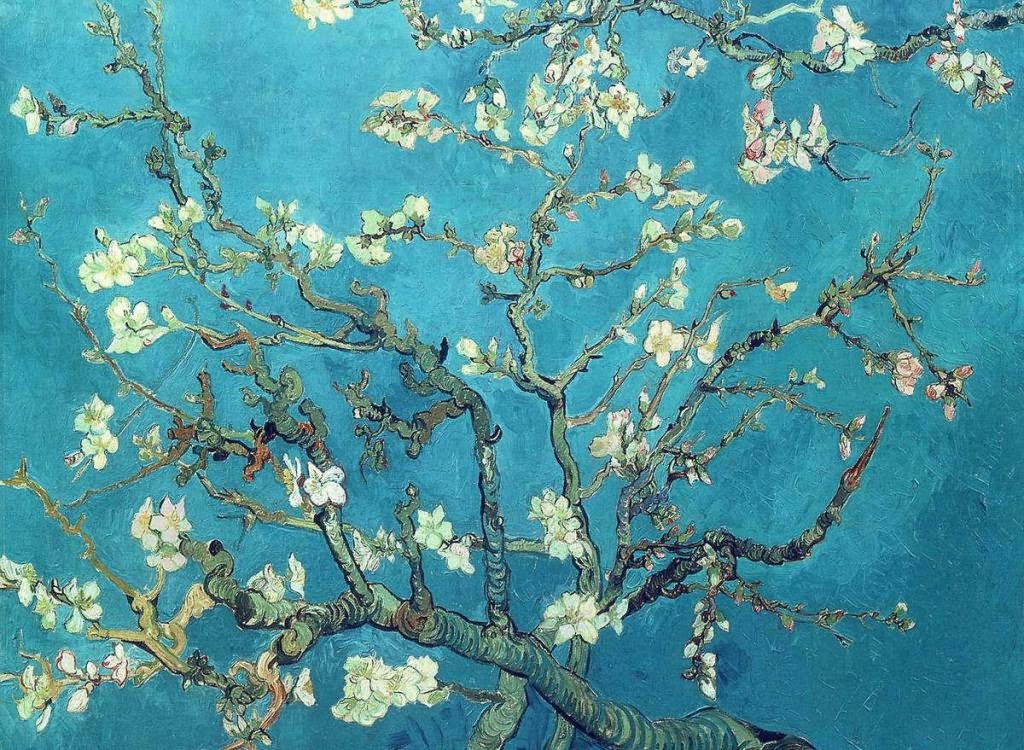Branches with Almond Blossom
Appreciation

Branches with Almond Blossom Nederland Vincent van Gogh Gallery and Appreciation
Blossoming Almond Tree is one of Vincent van Gogh's best known paintings and is noteworthy in that both Van Gogh and his closest family held the work in high regard. This painting is one of a small handful that Van Gogh produced with a particular person in mind--in this case, his brother and sister-in-law's newborn baby. Van Gogh was deeply moved when Theo and Johanna chose to name the child Vincent and he always harboured a great deal of affection for the child. Van Gogh painted Blossoming Almond Tree to honour his namesake and it remains a tour-de-force, both the product of Vincent's fondness for his nephew as well as the Japanese art which he so greatly admired.
Japanese Influences
Vincent van Gogh mentions Japan more than a hundred times in dozens of his letters to friends and family. Interest in Japanese art and culture was quite popular in Europe in the latter half of the nineteenth century. Edmond de Goncourt and Emile Zola, two writers that Van Gogh greatly admired, wrote extensively about Japan. Vincent, a devotee of both literature and art, would develop a deep admiration for Japanese culture via both of these media. Vincent was also a great admirer of the work of another writer, Pierre Loti, whose book Madame Chrysanthème, was highly influential in firing Van Gogh's imagination for Japanese traditions.
During the course of his career, Vincent would copy three Japanese paintings and several others were deeply influenced by his admiration for Japanese art (this self-portrait, for example). In 1888 Vincent wrote to Theo "About this staying on in the South, even if it is more expensive, consider: we like Japanese painting, we have felt its influence, all the impressionists have that in common; then why not go to Japan, that is to say to the equivalent of Japan, the South?" (Letter 500).
Blossoming Almond Tree has clear Japanese influences and may have been inspired by one of the more than 400 wood block prints in the collection of Vincent and Theo (now with the Van Gogh Museum in Amsterdam): specifically Three Beauties (right) by ukiyo-e artist Utagawa Kunisada (1786 - 1865).
Further on the influence of Japanese art on Van Gogh's paintings and drawings:
. . . Van Gogh's works of his Saint-Rémy and Auvers period still show some traces of Japanese influence. In his 'Death's-head moth', 'Butterflies and poppies' and 'Hyacinth', for example, Van Gogh depicted small plants and insects. Both the subjects and the asymmetrical close-ups are very similar to Japanese kachô (flowers and birds) pictures, which Van Gogh had seen on various occasions. In Arles Van Gogh had written about the reproductions in Bing's Le Japon Artistique: 'I think the drawing of the blade of grass and the carnations and the Hokusai in Bing's reproductions are admirable' [542]. 'Death's-head moth', 'Butterflies and poppies', 'Hyacinth' and other works of similar subject and composition not only show the mere pictorial influence of Japanese art, but also reveal Van Gogh's sympathy for the Japanese 'who live in nature as though they themselves were flowers' [542].
Without his sympathy for the Japanese as 'naturalists' and the inspiration from the kachô pictures, Van Gogh could possibly not have painted such monumental late works as the 'Irises', 'Branches of an almond tree in blossom', 'Roots and tree-trunks' and 'Ears of wheat'.
Mentioned in Letters
Vincent van Gogh frequently wrote to Theo and other artists about his ongoing projects. These letters give us a unique insight into Van Gogh's art works and progress as an artist. Blossoming Almond Tree is unique among his works in that he wrote about it not only to Theo and his sister, Willemina, but also to his mother. In addition, Theo's wife, Johanna, wrote to Vincent about Blossoming Almond Tree, clearly showing that the painting was not only well presented by Vincent, but also very well received by Theo and Johanna in Paris. As Vincent's final days approached, Blossoming Almond Tree, a delicate study of hope and renewed life, would stand as an ironic harbinger of the tragic summer that loomed ahead.
I started right away to make a picture for [Theo's son], to hang in their bedroom, big branches of white almond blossom against a blue sky.
Letter 627 Vincent to his mother St. Rémy, c. 20 February 1890
My work was going well, the last canvas of branches in blossom--you will see that it was perhaps the best, the most patiently worked thing I had done, painted with calm and with a greater firmness of touch. And the next day, down like a brute. Difficult to understand, things like that, but alas! it's like that.
Letter 628 Vincent to Theo St. Rémy, 15 April 1890
I felt ill at the time I was doing the almond blossoms. If I had been able to go on working, you can judge from it that I would have done others of trees in blossom. Now the trees in blossom are almost over, really I have no luck.
Letter 629 Vincent to Theo St. Rémy, 30 April 1890
I brought along a relatively large picture for Theo's and Jo's little boy--which they hung over the piano--white almond blossoms--big branches against a sky-blue background . . . .
Letter W22 Vincent to his sister, Wil Auvers-sur-Oise, 5 June 1890
What he does do is look at Uncle Vincent's pictures with a good deal of interest--the tree in blossom especially, which is hanging over his bed, seems to enthrall him.
Letter T30 Johanna van Gogh-Bonger to Vincent Paris, 29 March 1890